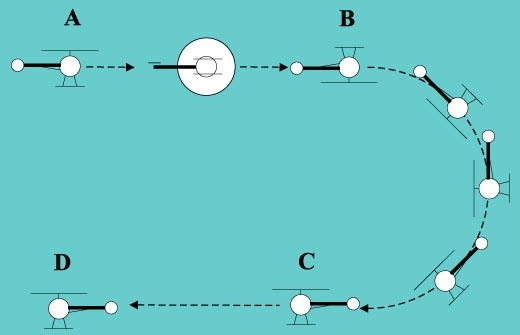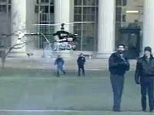A team of MIT researchers looked on recently as the pilot of their model X-Cell 60 helicopter flipped a switch on a remote control box. In response to this simple command, the chopper executed a complex maneuver never before performed autonomously by a helicopter.
It rolled 180 degrees, flew upside-down for an instant, then completed a half-loop to end up flying upright in the opposite direction. This maneuver, called a split-S, allows an aircraft to reverse direction quickly in a horizontally confined space. It is one of a variety of aggressive, agile maneuvers that the next generation of unmanned aerial vehicles (UAVs) will be expected to perform in military combat.
"It's the most complex maneuver ever completed automatically by any helicopter," said Eric Feron, a professor of aeronautics and astronautics and a researcher in the Laboratory for Information and Decision Systems who leads a team of researchers in aerial robotics.
With the U.S. military's campaign in Afghanistan in response to the Sept. 11 attacks and the related emphasis on homeland security, interest in UAVs for national defense has increased.
Vlad Gavrilets, the aero/astro graduate student primarily involved in the project, and colleagues spent the six months prior to the Sept. 12 flight programming the split-S maneuver into the helicopter's onboard computer and testing their results on a simulator. Late last year, they successfully demonstrated what they believe to be the first-ever autonomous maneuver by a helicopter: an aileron roll (a corkscrew-like maneuver).
Previously, such stunts required the skill of an elite pilot. The technology developed by the MIT team makes it possible for anyone to operate its aerobatic craft.
Small, agile, autonomous helicopters like MIT's X-Cell 60 could provide a new tool for military reconnaissance or weapons delivery in mountainous, urban and other challenging terrain that's off-limits to larger aircraft and too dangerous for manned aircraft. Their small size, operational ease and potentially low cost--in comparison with the current generation of UAVs, such as the Predator--make them especially appealing, and not just to the military. The entertainment industry could use miniature robotic rotorcraft as a new means of capturing aerial imagery.
Besides Gavrilets, other students who have played key roles in the project are postdoctoral associate Bernard Mettler, aero/astro graduate students Ioannis Martinos and Rodin Lyasoff, and alumni Kara Sprague and Alex Shterenberg, both of whom received the M.Eng. in electrical engineering and computer science in 2000. The robocopter's pilot is Raja Bortcosh.
The work is funded by DARPA, NASA and the Office of Naval Research.







